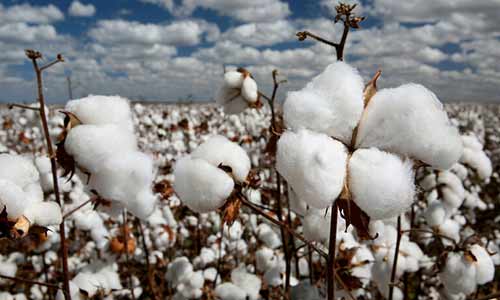Researcher of the Chinese Academy of Agricultural Sciences, has long been
engaged in the scientific study of corn and agricultural development strategy
research. With extensive theoretical knowledge and practice experience, Mr.
Tong acts as a senior consultant for both government departments and
non-government organizations.

Source: Baidu
Twenty years ago, China imported
pest-resistant genetically modified (GM) cotton in order to increase yield and
income for farmers and reduce pesticide usage amount to improve the ecological
environment. However, nowadays, China's cotton industry faces severe
development challenges. Minor pests strike cotton fields heavily, pesticide
consumption doubles, the quality of cotton fiber drops and the cotton planting
area shrinks dramatically.
1. Heavy strike by minor pests
In the 1990s, as bollworm struck the cotton
field in North China widely and heavily, farmers in Shandong and Anhui
provinces began to grow pest-resistant GM cotton. Since then, pest-resistant GM
cotton has gradually dominated the industry, from the Yellow River Plain Region
to the Yangtze River Plain Region. Nowadays, about 95% of the cotton fields in
China are occupied by pest-resistant GM cotton, with only a few fields in
Xinjiang Uygur Autonomous Region for non-GM cotton.
However, according to a 10 years' research
by experts in GM research such as Wu Kongming from the Chinese Academy of
Agricultural Sciences, the planting of GM Bt cotton in China has caused severe
problems. The quantity of some minor pests such as cotton mirids surges and
these pests strike the cotton fields more and more heavily, harming the
ecological environment severely.
According to experts' analysis, as the quantity
of cotton bollworm has been essentially controlled, the quantity of
piercing-sucking mouthparts pests such as cotton aphid, mirids, spider mite,
whitefly and thrips soared. Minor pests have become major pests and they struck
the fields heavily, leading to yield reduction or even crop failure in some
regions in China.
2. Increasing consumption of pesticides
As farmers had to spray highly concentrated insecticides to kill those minor pests, natural enemies of cotton bollworm such
as spiders, lacewings, ladybugs and oophagous trichogrammae were also killed.
As a result, the second-generation cotton bollworms spread like wildfire and
farmers had no choice but continued to enlarge the usage amount of
insecticides, worsening the ecological environment.
In addition to the heavy strike by non-targeted pests, the unprecedented
occurrence of "supper weed' also threated the safety of the ecological
environment in fields, leading to increasing consumption of pesticides.

3. Inferior quality of cotton fiber
On the China Textile & Clothing
Technological Forum held on 11 Aug., 2016, Yao Mu, an academician from the
Chinese Academy of Engineering reported: "The sterility rate of cottonseed of
conventional cotton was only 1%, but nowadays, that of pest-resistant GM cotton
has already increased to 12%, according to my research in 47 pieces of cotton
fields in Xinjiang Uygur Autonomous Region last year. This will lead to a
decline in cotton yield and inferior quality of cotton fiber.'
The planting of pest-resistant GM cotton has led to many problems, such as:
- Inferior quality of cotton fiber compared with that from conventional cotton.
The fibers were short and rough;
- The lint percentage (the transition rate of cottonseed into lint) presented
downward trend and even dropped to a level lower than that of conventional
cotton;
- Conventional cotton seeds were largely reduced or polluted and scientific
research on conventional cotton was marginalized.
4. Sharp decline in cotton planting area
China is one of the largest cotton planting
countries, consuming countries and importers. Since 2000, China's cotton
planting area has begun to decline. According to statistics from the Ministry
of Agriculture of the People's Republic of China, the total cotton planting
area in the county shank from 5.93 million ha (88.89 million mu) in 2007 to 4.86
million ha (72.73 million mu) in 2010 and to 3.43 million ha (51.49 million mu)
in 2015. The figure is very likely to further reduce to 3.10
million ha (46.50 million mu) in 2016.
Over half of the cotton planting area in the Yellow River and Yangtze River
plain regions was cut. In particular, in Dezhou City, Shandong Province, once
had a cotton planting area of about 200,000 ha (3 million mu), but in 2013, its
cotton planting area reduced to 75,300 ha (1.13 million mu) and in 2015, the
figure dropped to 28,700 ha (430,000 mu) only.
According to the 2015 Compilation of Costs and Profits of Agricultural Produce,
all Chinese major cotton producing provinces suffered losses and the national
average profit/cost ratio of cotton planting dropped to 30.13%.
On 17 April, 2016, the China Central Television reported the survival
challenges of cotton growers in Xiajin County, Dezhou City, Shandong Province.
They need more pesticides to control pests and reap sliding profits from
growing cotton. Some even lose about USD59.89 (RMB400) by growing one mu of
cotton (1 ha = 15 mu).
Since the introduction of pest-resistant GM cotton, China's cotton industry has
faced many development challenges and China has begun to rely on imported
cotton more. According to the General Administration of Quality Supervision,
Inspection and Quarantine of the People's Republic of China, China's import
volume of cotton accounted for about 25% or even over 50% of the country's
total yield. In 2015 when the inventory of domestically produced cotton was
huge, China imported 1.48 million tonnes of cotton. Large amount of imported
cotton has hit the domestic industry severely.
Author: Tong Pingya
This article expresses the personal view of the author, but not CCM's.
This article comes from Seed China News 1609, CCM

About CCM:
CCM is the
leading market intelligence provider for China's agriculture, chemicals, food
& ingredients and life science markets. Founded in 2001, CCM offers a
range of data and content solutions, from price and trade data to industry
newsletters and customized market research reports. Our clients include Monsanto,
DuPont, Shell, Bayer, and Syngenta. CCM is a brand of Kcomber Inc.
For more
information about CCM, please visit www.cnchemicals.com or get in touch with us
directly by emailing econtact@cnchemicals.com or calling
+86-20-37616606.
Tag: insecticides seed cotton